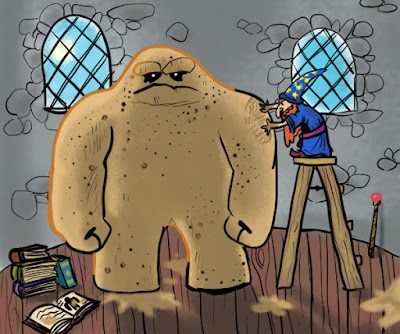Material
Clay - (AC 6 [13], HD 10, immune to non-magical bludgeoning weapons) Ruddy clay sculpted in a rudimentary image of the creature it is meant to resemble.
Stone - (AC 4 [15], HD 14, immune to non-magical weapons and attacks) Animated geometric statue that grinds as it moves.
Iron - (AC 2 [17], HD 18, immune to fire) Bulky, clanking automaton with eyes like burning coals.
Amber - (AC 6 [13], HD 8, immune to electricity, If attacked with metal weapons the attacker is shocked, save or drop weapon) Made of smooth, glossy amber crackling with tiny arcs of static electricity.
Crystal - (AC 4 [15], HD 7, half damage from magical attacks) Made of jagged, glowing, purple-white crystals. Bits of them levitate a few inches off the rest of the body.
Ice - (AC 7 [12], HD 5, healed by cold, double damage from fire) Slender, made from frosted elemental ice, spiky outcroppings along its joints or where its parts connect.
Flesh - (AC 8 [11], HD 9, immune to fire, cold, and electricity, damaged by healing magic) Made from patchwork corpse parts with spidering veins full of black blood.
Brass - (AC 0 [19], HD 20, if damaged by an edged weapon, emits a spurt of scalding steam, save or 2d6 damage, attacks deal 1d10 bonus damage from heat). Constructed with elaborate joints and mechanisms coursing with steam.
Body Type
Humanoid - 2x fist (2d6) + grab (2d4, breaks armor), can wield weapons
Cat - 2x claw (2d6), bite (1d10)
Serpent - 1x bite (2d8) + constriction (2d4 each round, STR check to escape)
Bird - 1x talons (1d6), 1x bite (1d10), flight
Insect - 1x bite (1d8), spiderclimb
Bull - 1x gore (2d6) and charge (20’ running start, double damage gore attack to all in the path)
Fish - 1x bite (1d10) + ram (save or be stunned for 1d3 rounds), swim
Chimera. Roll twice for body type and combine them.
Special Ability
Regeneration - The golem is able to reconfigure its body as you chip away at it, regenerating 3 hp per round.
Elemental Blast - The golem can fire a blast of elemental energy. Save vs. wands or take 1d8 damage.
Spells - The golem can cast one 3rd level spell OR two 2nd level spells per day. Spells are chosen randomly.
Self-Destruct - When the golem is killed (or given the order by its master), it explodes. Everyone within 10’ must save vs. breath weapons or take 3d6 damage.
Weapon Attachment - The golem has built-in weaponry. Weapon Type (1d4): 1. Spiked flail (1d6, reach) 2. Blade (1d8) 3. Sledgehammer (1d10, slow) 4. Ballista (2d6).
Energy Aura - The golem is surrounded by a field of elemental energy, dealing 1d4 damage per round to anyone in melee range. The element depends on the golem’s material (amber golems have crackling electricity, ice golems get swirling icy winds, etc).
Extra Limbs - The golem has an extra pair of limbs it can use to make an additional attack per round.
Shrapnel - The golem can launch pieces of itself as a missile attack (1d6), golem loses hp equal to half the attack’s damage each time this is used.
Power Source (what to destroy to make the golem stop working)
Paper talisman inside the golem’s mouth.
Glowing rune scribed into the golem’s forehead.
Gemstone embedded in the golem’s back.
Tongue of flame burning inside the golem’s hollow chest.
Magic words. Speak them and the golem shuts down.
Amulet worn by the golem’s master.
Someone inside the golem controlling it like a mech.
Ghost possessing the golem as a vessel. It can be turned by a cleric to exorcise it.





